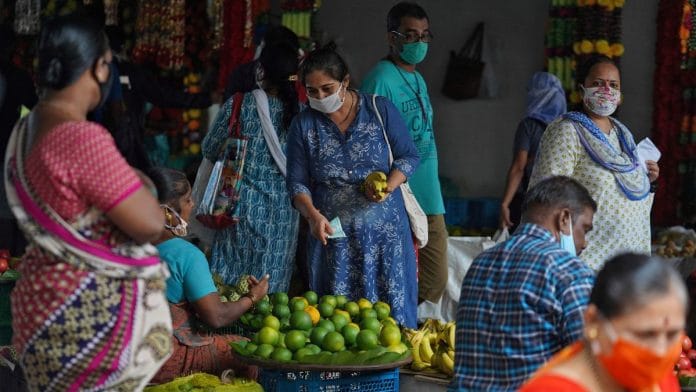New Delhi: The Centre Monday confirmed the detection of the Human Metapneumovirus (HMPV) in two patients in Karnataka as part of an exercise to monitor respiratory illnesses across India, but played it down given that the virus has already been in circulation across the world for many years.
A 3-month-old female infant, who was diagnosed with HMPV after being admitted to Baptist Hospital, Bengaluru, has since now recovered and been discharged, while the 8-month-old male infant, who tested positive for HMPV on 3 January after being admitted to the same hospital, is recovering, the Union Ministry of Health said in a statement
Both infants had a history of bronchopneumonia—a type of pneumonia that affects the bronchi. Neither had travelled abroad.
“Both cases were identified through routine surveillance for multiple respiratory viral pathogens, as part of ICMR’s ongoing efforts to monitor respiratory illnesses across the country,” the statement said.
It added that, according to current data from the Indian Council of Medical Research (ICMR) and the Integrated Disease Surveillance Programme (IDSP) network, there has been no unusual surge in Influenza-Like Illness (ILI) or Severe Acute Respiratory Illness (SARI) cases in the country.
Given that HMPV is a common virus, the government did not previously keep data on the number of cases.
Surveillance was increased even as media reports in China claimed that hospitals in the country were overwhelmed with patients exhibiting symptoms of respiratory infections and unverified videos on social media also show crowded medical facilities, primarily children’s hospitals—raising alarm five years after the COVID-19 pandemic first struck.
The reports suggested that the surge was likely caused by HMPV. However, there has been no official confirmation by the Chinese health authorities on this so far. There are also reports of a surge in respiratory illnesses from Malaysia.
However, as ThePrint reported earlier, virologists have played down the surge, saying that China’s heightened surveillance and stricter measures post-Covid may be behind the rise in reported cases of HMPV.
They also emphasised that HMPV is a known virus and typically leads to a rise in respiratory illnesses during the winter. In general, respiratory illnesses tend to rise during the winter as the cold lowers immunity and people spend more time indoors.
“HMPV is not a new virus. It has been recognised for decades. Unlike the Covid virus, which was a newly detected, novel virus, HMPV has been circulating for many years,” Dr Sandeep Budhiraja told ThePrint Monday.
The clinician—group medical director and senior director at the Institute of Internal Medicine at Max Healthcare—added that typically, during the winter months, known as flu season, numerous respiratory viruses circulate, particularly in the northern hemisphere.
“In addition to viruses, certain bacteria like Mycoplasma pneumoniae also contribute to respiratory illnesses, along with some less commonly recognised viruses,” Budhiraja said.
‘Monitoring situation’
In its statement Monday, the Union Ministry of Health said it was monitoring the situation through all available surveillance channels.
It also said that the ICMR will continue to track trends in HMPV circulation throughout the year, further making it clear that the World Health Organization (WHO) is already providing timely updates regarding the situation in China to further inform ongoing measures.
The recent preparedness drill conducted across the country has shown that India is well-equipped to handle any potential increase in respiratory illnesses and public health interventions can be deployed promptly if needed, the Centre stressed.
One of the viruses behind respiratory infections
HMPV, identified first in the Netherlands in 2001, primarily causes respiratory symptoms similar to the flu or common cold, including fever, cough, nasal congestion, and in severe cases, can lead to bronchitis or pneumonia.
Symptoms can be more severe among young children, the elderly, and those with weakened immune systems.
The pathogen spreads through respiratory droplets from coughing or sneezing, direct contact with infected individuals, and touching surfaces contaminated with the virus.
Experts estimate that HMPV is detected in approximately 3–10 percent of hospitalisations of children under five years old with acute lower respiratory tract infections worldwide.
The diagnosis involves identifying HMPV as the cause of respiratory symptoms and, since it shares symptoms with other respiratory infections like Respiratory Syncytial Virus (RSV), influenza, or COVID-19, laboratory testing is often necessary for a definitive diagnosis.
Techniques include Polymerase Chain Reaction (PCR) tests, antigen detection and viral cultures
Since there is no specific vaccine, care for infected patients is supportive, focusing on relieving symptoms and managing complications, according to clinicians. Supportive measures may include hydration, fever reducers such as acetaminophen or ibuprofen, oxygen therapy in severe cases and mechanical ventilation for critically ill patients.
(Edited by Sanya Mathur)






